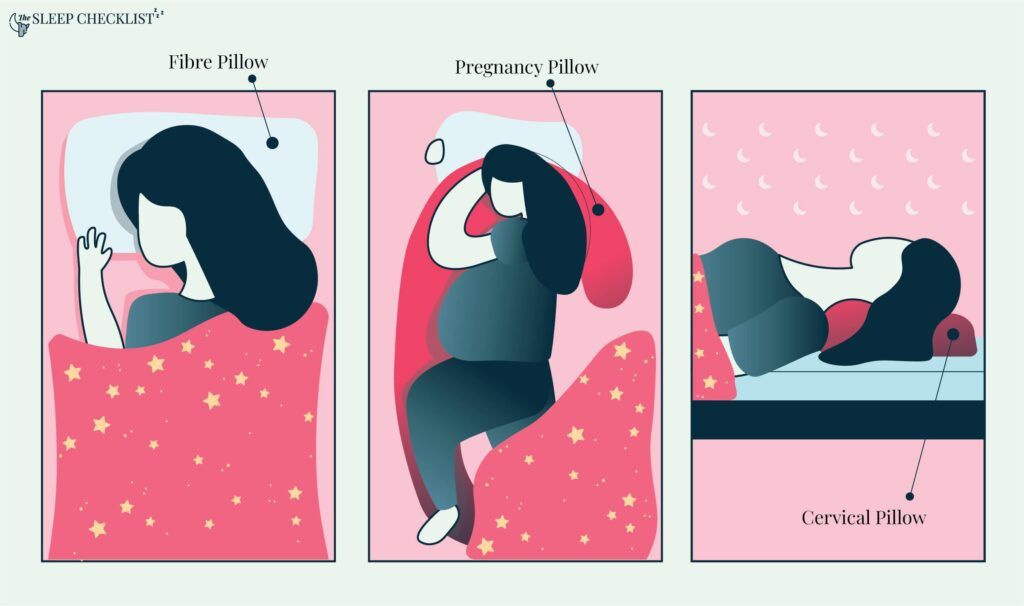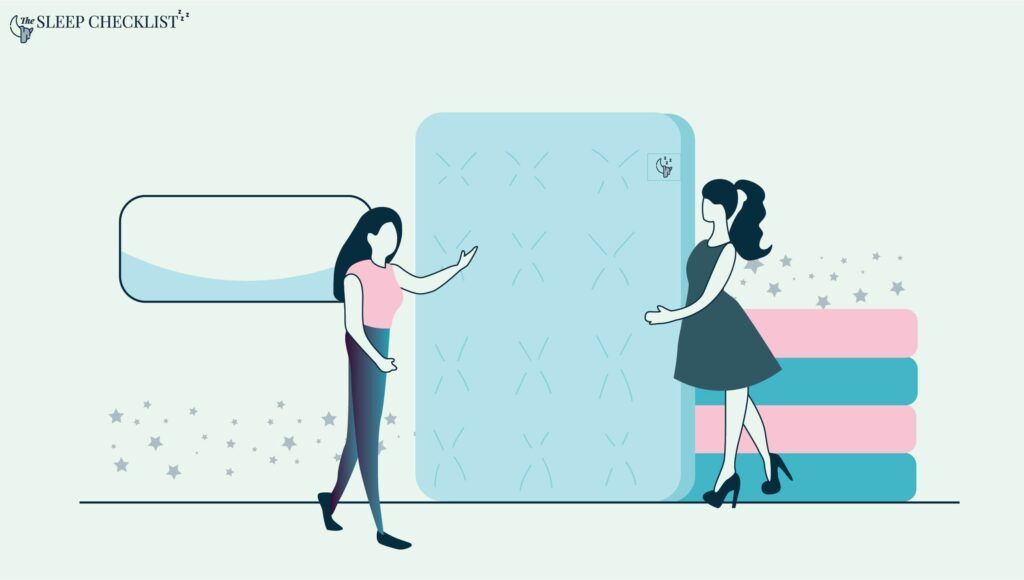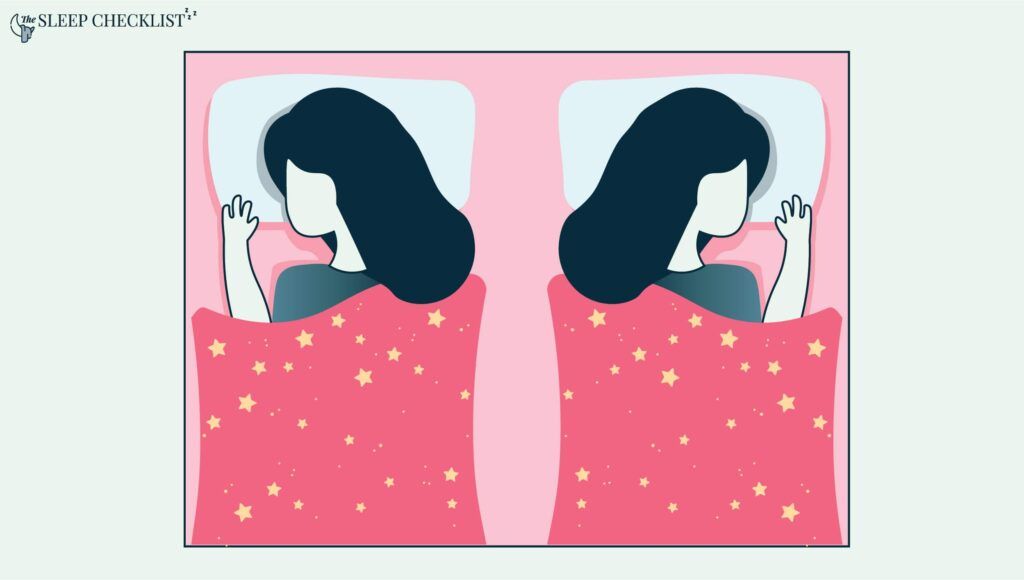Maybe you’re here because you’re in the 60% of adults that side sleep and want to know more about it. Or perhaps your GP advised you to switch sleeping positions?
From switching from stomach to side sleeping or back sleeping to side sleeping, these ache-saving tips teach you how to sleep on your side.
If your body is automatically switching to its regular, non-side sleeping position come morning then keep reading.
We know this seems daunting, but as certified sleep experts, we wanted to share our facts about side sleeping and practical tips to successfully make the switch. Read on!
Tips and Tricks On How to Sleep On Your Side
To train yourself to sleep on your side, there are a few methods to try:
Pillow Method
For this method, you need quite a few pillows. Good choices include:

- Fibrefill pillows
- Pregnancy pillows
- Cervical pillows
And just about any type of pillow in between. This method prevents your body from returning to your default sleeping position at night.
Place the pillow(s) beside you, so your body is discouraged from moving.
For example, if you are a back sleeper, place two pillows (one on each of your sides) so that whenever your body wants to shift to the back sleeping position, the pillows prevent you from doing so.
If you have chronic knee pain that prevents you from sleeping on your side, you can use a pillow between your knees to keep them comfy so your body won’t switch positions too much.
Investing In a New Mattress

Invest in one of the best mattresses for side sleepers can help you make the switch. How does a new mattress help a side sleeper?
- Your body may be so used to sleeping in your normal position that you can’t change it.
- Your mattress does not give your body the support it needs to sleep on your side.
- A mattress that’s too soft can strain your body’s alignment due to you sinking in too much.
The best mattress firmness, according to a study, is a medium-firm mattress designed to support the body of a side sleeper.
Pros of Sleeping On Your Side
The advantages and benefits of sleeping on your side are:
- It can potentially reduce joint and low back pain. Sleeping on your side relaxes your joints and muscles so long as your spine and head are correctly aligned.
- Recommended position for pregnant women. Side sleeping eliminates the pressure and weight from the baby bump and is carefully supported by the bed during sleep.
- It can alleviate symptoms of acid reflux and other GI problems. The left side, specifically, is known to be where you can reap the most benefits regarding acid reflux and other known GI problems.
- Accommodates faster waste removal in our brains. This means less groggy mornings, laser-sharp focus, and exceptional memory recall throughout the day.
- It can potentially reduce instances of sleep apnoea. This means you snore less and can breathe easier while sleeping, leading to less sleep disruption.
Cons of Sleeping On Your Side
Aside from pros, there are also cons of sleeping on your side:
- It can cause shoulder and neck pain. This is usually caused by a mismatch in the alignment of your head and spine. Pain occurs if your head is misaligned to your spine since pressure is constantly applied to your neck and shoulders throughout the night.
- Sleeping on your left side places pressure on your thoracic area. According to a recent study, this is because there are significant electrical changes in the heart when a person with a heart problem sleeps on their side.
- It can cause paresthesia, or the numbing of the hands. This is likely caused by maintaining odd positions of your wrist and arms during sleep. Relax your body before sleeping.
- It can cause wrinkles to develop. Since one side of your face is buried in your pillow, friction occurs, and your skin loses elasticity, leading to wrinkles and fine lines.
What Side To Sleep On? Left or Right?

Don’t know what side to sleep on? There are various benefits on each side which we’ll get to know below:
Left Side
The left side is commonly favoured as the more ‘beneficial side’ than the right. But this largely depends on your medical condition.
If you have acid reflux or are pregnant, the left side is the most suitable.
Right Side
If you experience heart problems, the right side might be the best for you.
If you’re not sure about your current medical condition, make it a good habit to consult with your GP for appropriate medical advice.
If you don’t have any particular medical condition, listening to which side your body tells you to sleep on is probably the best way to pick.
How To Sleep On Your Side Without Any Sort Of Pain?
If you have experienced pain after a night of sleeping on your side and you’re wondering if there are any possible ways to avoid this, yes, there are!
You can sleep on your side and wake up feeling refreshed and without any type of pain throughout your body by making just a few adjustments to your sleeping position.
To do this, you should have multiple pillows around for you to use. One for your head, one for your neck, one for your knees. This helps ensure the pressure points in your body are properly supported.
You can also look for better pillows and mattresses or invest in a high-quality mattress topper that fits your personal preferences.
10 Sources
- Cary D, Briffa K, McKenna L. Identifying relationships between sleep posture and non-specific spinal symptoms in adults: A scoping review. BMJ Open. 2019;9(6):e027633. Published 2019 Jun 28. doi:10.1136/bmjopen-2018-027633
- Jacobson BH, Boolani A, Dunklee G, Shepardson A, Acharya H. Effect of prescribed sleep surfaces on back pain and sleep quality in patients diagnosed with low back and shoulder pain. Appl Ergon. 2010;42(1):91-97. doi:10.1016/j.apergo.2010.05.004
- Dainese R, Serra J, Azpiroz F, Malagelada JR. Influence of body posture on intestinal transit of gas. Gut. 2003;52(7):971-974. doi:10.1136/gut.52.7.971
- Lee H, Xie L, Yu M, et al. The Effect of Body Posture on Brain Glymphatic Transport. J Neurosci. 2015;35(31):11034-11044. doi:10.1523/JNEUROSCI.1625-15.2015
- Lee WH, Ko MS. Effect of sleep posture on neck muscle activity. J Phys Ther Sci. 2017 Jun;29(6):1021-1024. doi: 10.1589/jpts.29.1021. Epub 2017 Jun 7. PMID: 28626314; PMCID: PMC5468189.
- Pan H, Xu Z, Yan H, Gao Y, Chen Z, Song J, Zhang Y. Lying position classification based on ECG waveform and random forest during sleep in healthy people. Biomed Eng Online. 2018 Aug 30;17(1):116. doi: 10.1186/s12938-018-0548-7. PMID: 30165874; PMCID: PMC6118000.
- Roth Bettlach CL, Hasak JM, Krauss EM, Yu JL, Skolnick GB, Bodway GN, Kahn LC, Mackinnon SE. Preferences in Sleep Position Correlate With Nighttime Paresthesias in Healthy People Without Carpal Tunnel Syndrome. Hand (N Y). 2019 Mar;14(2):163-171. doi: 10.1177/1558944717735942. Epub 2017 Oct 11. PMID: 29020829; PMCID: PMC6436122.
- Goesel Anson, MD, FACS, Michael A.C. Kane, MD, Val Lambros, MD, FACS, Sleep Wrinkles: Facial Aging and Facial Distortion During Sleep, Aesthetic Surgery Journal, Volume 36, Issue 8, September 2016, Pages 931–940,
https://doi.org/10.1093/asj/sjw074 - Person E, Rife C, Freeman J, Clark A, Castell DO. A Novel Sleep Positioning Device Reduces Gastroesophageal Reflux: A Randomized Controlled Trial. J Clin Gastroenterol. 2015;49(8):655-659. doi:10.1097/MCG.0000000000000359
- Leung RS, Bowman ME, Parker JD, Newton GE, Bradley TD. Avoidance of the left lateral decubitus position during sleep in patients with heart failure: relationship to cardiac size and function. J Am Coll Cardiol. 2003;41(2):227-230. doi:10.1016/s0735-1097(02)02717-1






